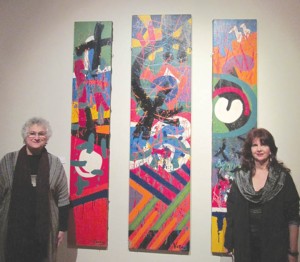Aramayis Arkusyan
Staff Writer

With the one hundred year anniversary of the Armenian Genocide fast approaching, the Fresno community has been teeming with events commemorating the tragic year that left the history of the Armenian people stained with blood.
Among the many local organizations participating in the commemoration of the Genocide Centennial, under the umbrella of the Armenian Genocide Committee-Fresno, the Fresno Art Museum is showcasing a new exhibit Tradition, Legacy, Culture, featuring works by internationally and regionally renowned artists of Armenian descent.
The exhibit, which opened on January 23, displays the artwork of John Altoon, Varujan Boghosian, Ara Dolarian, Charles Garabedian, Arshile Gorky, Khachik Khachatouryan, Ed Marouk, Rueben Nakian, Varaz Samuelian, William Saroyan, and Arminee Shishmanian, and will remain on display through April 26.
When reflecting on the Genocide, images of sorrow and grief are among the first that come to mind. Yet, when I entered the exhibit for the first time, I was delightfully surprised to find that none of the artwork – with the exception of one – was themed with the Armenian Genocide.
Instead, bronze figurines of Armenian dancers and musicians filled the museum with folk rhythms that have comprised Armenian rituals and daily life since ancient times. Lively circular scribbles by Saroyan that resembled the shape of grapes, symbolic of Armenia’s deep roots in agriculture and ties to the Central Valley, blanketed the walls.
It was clear that rather than commemorating the Genocide through a focus on the atrocities of the past, the artwork displayed in the Fresno Art Museum was selected to celebrate the rich heritage of the Armenian culture, which continued to flourish and thrive despite the trials and tribulations of the past century.
As I made my way around the exhibit, a certain sense of cultural pride overtook me, and I was reminded of the following lines from Paruyr Sevak’s poetry: “Simply we know how to build from the rock, a monastery; How to make fish from stone, how to make man from clay.” Craftsmanship, as noted by Sevak, is an integral part of the Armenian culture, and the artwork displayed in the exhibit was a testament to this fact. What most others would have viewed as trash, the artists had crafted into beautiful collages. Where others would simply see plain bronze or steel, the artists had envisioned elegant sculptures. Reminiscent of the expert hands that crafted the Armenian cross-stones, the skillfully constructed artwork displayed in the exhibit are a reminder that artistry is part of the Armenian identity.
The significance of the exhibit is perhaps best encapsulated in the quote from Saroyan that “The role of art is to make a world which can be inherited.” Although spread across the four corners of the world, art – through its ability to transcend geography – has acted as a silver thread that has kept us bound as one.
Simply attend any event where two Armenians meet and dance their way to exhaustion through a “shurj par” and you will witness a moment of shared cultural identity.
As we prepare to commemorate the centennial of the Armenian Genocide, maintaining the Armenian identity throughout the Diaspora becomes of paramount importance.
For the Armenian community of Fresno, the Tradition, Legacy, Culture exhibit has provided a method for doing just that.
 Hye Sharzhoom Armenian Action
Hye Sharzhoom Armenian Action